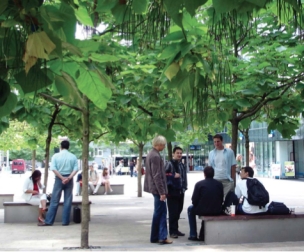I was introduced to the work of William H. Whyte in Jamie Allen’s Media in Public seminar series at Culture Lab last year. I wanted to include a reference to Whyte’s work here both as an interesting public realm observation study and as an example of ‘unobtrusive’ visual methods in action. Working primarily in New York City, Whyte was an influential advocate for the design of ‘sociable’ urban spaces. Whyte is best known for his detailed observation study of daily pedestrian life in New York City, particularly in the public plazas of central Manhattan in the 1970’s-80’s. His work was the inspiration for the establishment of the New York based Project for Public Spaces, a not for profit urban design and educational organisation dedicated to helping communities create and sustain positive public spaces in the City.
This short film by Whyte made c.1980 provides an entertaining and stylishly retro visual summary of his research approach, ideas and findings based on his work on the New York City Street Life Project, including (for my own research project) a particularly relevant section reporting on pedestrian encounters with public artworks (including di Suvero’s Joie de Vivre, Dubuffet’s Groupe de Quatres Arbres and Nevelson’s Night Presence). You’ll have to watch through or skip to the end to find this.
References:
Whyte, W. H. (1998) City: Rediscovering the Centre. New York, London, Toronto, Sydney, Auckland: Doubleday
Whyte, W. H. (1980) ‘The Social Life of Small Urban Spaces’, in Orum, A. M. and Neal, Z. P.(ed), Common Ground. New York, Abingdon: Routledge, pp. 32-39.




